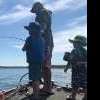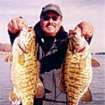This thread covers several topics that books have been written on. Keep in mind bass fishing term defintions vary regionally.
Structure; permanent features that make up the lake bottom ; dirt, sand, gravel, rocks boulders, dams, channels and man made features like pier post, cribbs etc.
Cover; vegetaion that grow or float on or in the water column and trees that provide shade in or near the water, man made docks, walk ways, etc.. Your the bass are northern strain largemouth and small mouth bass. The 2 bass are vary different in behavior and habitate, they both like to feed on Crawdads and dermasil bait fish and may also target pelagic bait fish if the lake has them; herring, aliwifes etc. Up north the LMB tends to be cover oriented, the small mouth structure oriented, but they will over lap.
The Small mouth bass are more mobile and roam a lot in schools, LMB are less mobile and tend to stay nearer to cover.
Barometric pressure changes affect the weather and lower light period give the bass an advantage to feed, brighter light can give the prey an advantage to see the bass easily, so the bass tend to use cover or structure shadows to conceal themselves to ambush prey. The biggest barometric affects re very low pressure that brings in cloudy or storms and very high pressure that tends to create high winds and bright conditions. The bass are conditioned to barometric changes, it's a normal factor in their life cycle.
It's a lot easier to catch active bass and more challenging to catch inactive bass and bass are active only about 20% of the time during a 24 hour cycle. Look for and target active bass with faster moving lures, then slow down and use slower moving lures when the bass are less active. How do you when to do what; look around for signs of activity and feeding fish, every lake has a different time schedule and that is something only you can determine with practice and time on the water.
Tom



